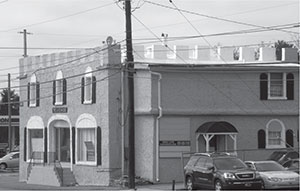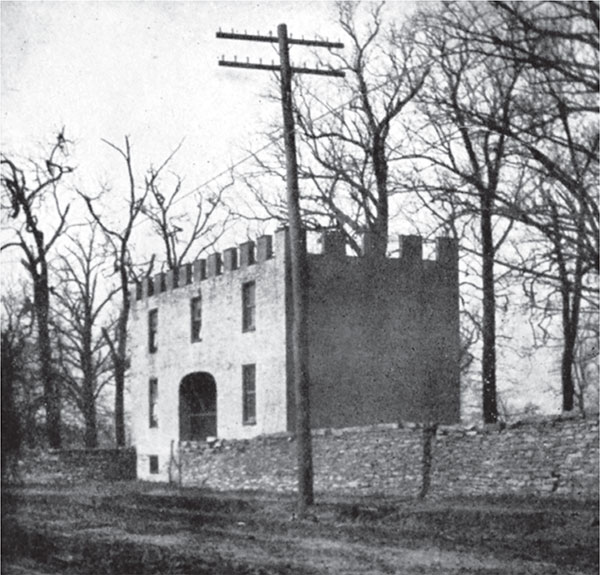
FORGOTTEN FARMS
A direct consequence of municipal growth is that farmland becomes city land. When a significant portion of that growth is occasioned by people moving into the community, many don’t know or even stop to think that their house or apartment or condo might be in what was once the infield of a racetrack or the pasture of a horse farm. This chapter looks, in no particular order, at a few of the former horse farms now in the city of Lexington, Kentucky, or, more accurately, the Lexington-Fayette Urban County Government.
MEADOWTHORPE STUD
Meadowthorpe subdivision is located on the Leestown Pike west of downtown Lexington. A farm of long standing, it was sold in 1886 to William H. Cheppu, whom the Lexington Transcript identified as a well-known bookmaker during the era when bookmaking was an acknowledged occupation. However, Cheppu was not ultimately successful in his calling, and an “overdraft” of $32,000 forced him to sell his 222-acre farm in 1892. The purchaser was Colonel James E. Pepper, owner of the Pepper bourbon distillery on Manchester Street, which he founded in 1869. The area is currently experiencing a commercial revival known as the Distillery District. Subdivision of the farm into residential lots began in 1949 and now consists of 498 properties.362 Pepper has been described as “one of Kentucky Whiskey’s first families” and a famous thoroughbred breeder in his time who established Meadowthorpe Stables and Meadowthorpe Stud on the property.363
This former thoroughbred farm has one more distinction, however, between its use as a horse farm and its conversion into residential use: it was Lexington’s first municipal airport. It was known as Halley’s Field after then owner Dr. Samuel Halley, and airplanes began landing there as early as 1921, with the city airport officially opened May 28, 1927. The famous aviator Charles Lindbergh landed there on March 28, 1928. Halley Field hosted air circuses, air shows, flight training lessons and served several small airlines. The property reverted to farmland in 1934.364
Halley Field quickly became obsolete as large airplanes, multiple-engine craft and runway restrictions came about. The Airport Committee of the Board of Commerce leased Glengarry Farm, later known as Cool Meadow Farm, on the Newtown Pike for a new airport in 1930. It served the community for about twenty-five years until the current Bluegrass Field was built in the 1950s across from Keeneland Race Course. Cool Meadow today is home to the Fasig Tipton Company.
BELL PLACE
Across the Richmond Road from the western portion of Henry Clay’s Ashland was Bell Place, which around 1900 was owned by the third generation of the Bell family. The farm featured dense woods except for about an acre immediately around the ornate main house. As with other former farms, particularly one barely outside the city limits, this is now an established residential area. However, the main house and grounds are now owned by the municipal government. The carriage house and stable are now home to a community theater.365
MERRICK PLACE
Merrick Place, the horse farm, was established before the Civil War on Tates Creek Pike.366 The manor house was extensively remodeled by Cal Milam in 1836. Milan trained Exterminator, who won the 1918 Kentucky Derby, as well as Tut Tut, who won every race he entered in 1920 as a two-yearold thoroughbred, and several other successful horses. Milam’s most famous horse, however, was Merrick, bred in 1903. He won 62 races in his career and overall finished in the money 157 times. When the horse died in 1941 at the age of thirty-eight, he was the oldest thoroughbred on record. Merrick is buried in the grassy circle in front of the Merrick Inn.

Merrick Inn. Photograph by author.
Currently, the former farm is the location of a large apartment complex. The manor house has been home to the Merrick Inn, one of Lexington’s premier restaurants, for more than forty years.367
KIRKLEVINGTON
On the other side of Tates Creek Pike and slightly farther from town from Merrick Place was the five-hundred-acre training and breeding farm of Kirklevington. It has been described as a “superbly located, well watered” estate with “sloping hillsides, picturesque lowlands and unmolested woods.” In the early 1900s, it was owned by Archie L. Hamilton, who, while maintaining his own stable, focused on breeding and training thoroughbreds owned by wealthy out-of-state clients.368
PENMOKEN FARM
Along the present South Limestone/Nicholasville Road corridor, lying on the west side between present Southland Drive and Rosemont Garden, was the Penmoken Farm. It was about two hundred acres in size and, in contrast to other farms mentioned, had a large herd of Shetland ponies. It is also a residential subdivision.369
INGLESIDE FARM
Described in 1903 as being “almost at the gates of Lexington,” Ingleside Farm was on the road to Harrodsburg now called South Broadway. The family of Colonel Hart Gibson bred both thoroughbred and standardbreds at the turn of the past century. The prominent feature of the entrance was a two-story “porter’s house” in the middle of which was an arched gateway into the farm, topped with what appear to be castle-like battlements. While the farm has been developed, the porter’s house remains, the archway filled in and the whole repurposed for offices. Were it not for the battlements, it would not be recognizable.370

Ingelside Farm (former) gatehouse, 2018. Photograph by author.

Ingelside Farm gatehouse, circa 1900. Country Estates of the Bluegrass.
SPRINGHURST FARM
The Springhurst Farm was on the east side of Harrodsburg Road, farther out from Ingleside, being about 160 acres opposite the present Turfland Mall. During the 1800s, it was a premier thoroughbred breeding operation under the Pattersons. In 1893, Charles Railey purchased the property and converted it into a saddlehorse breeding and training farm and for several years showed championship horses. A spring on the property was reputed to have been the site of a “pitched battle” between certain Indian tribes. Today, it is residential and can be located by the fact its central street is named for the farm.371
BEAUMONT FARM
Beaumont Farm contained more than eight hundred acres and was a well-established thoroughbred breeding farm by 1900. Operated at that time by Hal Price Headley, it had a deserved reputation for fast horses and beautiful pastures, paddocks and farm buildings.372 Beaumont subdivision today has primarily business and commercial areas along Harrodsburg Road, blending into a mix of townhouses and apartments on into single family residences.
MCGRATHIANA FARM
McGrathiana Farm was located on the Newtown Pike north of Lexington and contained more than twenty-two hundred acres. Thoroughbred horses bred there by Colonel Milton Young won “fame and fortune” for their owners on racetracks in the United States and Europe.373 The name comes from Price McGrath, who once owned it. Today, it is an office and research park owned by the University of Kentucky.
LOUDOUN FARM
Loudoun Farm was situated northeast of Lexington a century ago, with stands of trees dating to the colonial period and before. The curtilege is dominated by an imposing, castle-like house. One owner, Colonel William Cassius Goodloe, served as the United States minister to Brussels, and he brought back from Europe hand-carved furniture with which he populated the grand drawing room.374 Today, the land around the farm is residential and Loudoun House is owned by the Lexington government and serves as headquarters for the Lexington Art League.
GAINESWAY FARM
In 1944, Clarence F. Gaines bought 280 acres on the Tates Creek Road, where he located his standardbred horse-breeding operation, which he had started in 1925. He averaged about forty-two mares and bred mostly to his own stallions.375 Upon his death, his son John Gaines took over the business and farm; however, his plan relied more on the stallion side of the business, and John increased the number of studs and reduced significantly the number of mares.376 In 1957, John sold the farm to a development company of which he was a co-owner in what was described at the time as “the largest land purchase for home building purposes in Central Kentucky.” By then, the farm had increased in size to more than 300 acres. The intent was to create a “country club” style estate with the houses surrounding a clubhouse with tennis courts, a swimming pool, a baseball field and a stocked fishing pond. Two barns were to be retained for the use of the owners as stables, and bridle paths were to lead through the property.377

Entrance to Gainesway subdivision. Photograph by author.
The resulting development, however, was at odds with the original concept. A large space in the middle area became the campus for the Tates Creek public elementary, middle and senior high schools, and a significant portion became a public golf course, although it does have a pool.
PATCHEN WILKES FARM
Patchen Wilkes Farm is located on the Winchester Road east of Lexington. In 1900, it contained several thousand acres and was a trotting-horse operation with large barns for colts and mares, a training barn and its own training track. Many notable standardbred horses were bred, raised and trained on the farm, and at one time four notable stallions, including namesake Patchen Wilkes, were standing at stud.378 Current owner Warren Rosenthal changed the farm to a thoroughbred farm when he acquired it and is presently developing the portions along Winchester Road into upscale residential houses. The farm itself is bordered on three sides by developed areas and on the fourth by an interstate.
HAMBURG PLACE
Across Winchester Road from Patchen Wilkes and likewise bordered by developed land and an interstate is Hamburg Place. John E. Madden, famously the “Wizard of the Turf,” sold the horse Hamburg in 1897 for more than $40,000, setting a record price at the time for a horse in training. He used $30,000 of the proceeds to purchase a 235-acre farm then known as Overton Place. Henry Clay is said to have been married in the main house on the farm.379 By 1903, the farm had been expanded by Madden to 1,600 acres.380 Just a few years later, the farm reached its ultimate size of 2,000 acres.
Madden changed the name of the farm to Hamburg Place in honor of the horse that provided the initial funds to purchase it, and he began developing his breeding and training operations. Madden, who had boxed, frequently for prize money, in his youth, built a two-story gymnasium on the farm and frequently held boxing matches.381 In time, he ceased control, and operations passed to his sons. In 1956, grandson Preston Madden assumed control and began breeding, training and selling horses.382 He developed a five-and-one-half-furlong training track on the property with a carefully calculated spiral easement for the turns, enabling a rider to breeze a horse for a half mile without making sharp turns. The track also had both a dirt surface on the inside and a turf surface on the outside, the weather dictating which surface was used for training.383
In 1964, Interstate 75 cut through Hamburg Place, leaving 1,200 acres on the “inside” or Lexington side of the highway and 700 acres on the east side. The Madden family has begun development of the property on the Lexington side with a regional shopping mall, offices and apartments and residential lot sections. Plans eventually call for the section on the east of the interstate to be developed as well.384